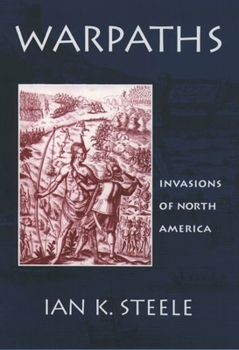Warpaths: Invasions of North America
Select Format
Select Condition 
Book Overview
In 1513, only a few years before Cortes conquered the Aztec empire, Juan Ponce de Leon and three shiploads of conquistadores landed just south of what is now St. Augustine, Florida. The Spanish adventurers, however, were quickly driven away by the Timucua people; further landings were similarly defeated by the extraordinary archers of the Calusa, who ultimately took the lives of Hernandez de Cordoba and Ponce de Leon himself. Clearly, the European...
Format:Paperback
Language:English
ISBN:0195082230
ISBN13:9780195082234
Release Date:February 1995
Publisher:Oxford University Press, USA
Length:304 Pages
Weight:1.30 lbs.
Dimensions:0.8" x 6.2" x 9.3"
Customer Reviews
4 ratings
good book
Published by Thriftbooks.com User , 14 years ago
if you enjoy books like howard peckhams colonial wars, and francis parkmans montcalm and wolfe, youll enjoy this. Its great.
Reassess early North American history
Published by Thriftbooks.com User , 15 years ago
This was required reading for a graduate course in the history of American military affairs. In the preface of Warpaths: Invasions of North America, Ian K. Steele stated that it was his goal to reassess early North American history by welding together the historical disciplines of ethnohistory and the history of early colonial wars. This reader found he did an admirable job at studying the two historical disciplines without the usual injection of racial prejudice, victimization, or "hero worship" which has too often been attached to historical accounts of the early colonial era. Steele's book, written in three parts from1565 to 1684, described the history of five areas of European invasion in North America by the Spanish, English, French, and Dutch. Part II was a study from 1687 to 1748, examining how the expansion of colonies invariably produced conflict between European settlers and Amerindians as well as combat between Amerindian tribes as they became caught up in European rivalries in North America. Part III was a very useful analysis by Steele in the adoption of the European method of warfare brought to North America; specifically by the English and French militaries after 1748. He ends the book in 1765 with a "negotiated" peace, albeit short lived as history will bear out, between Amerindians and the English and French colonial powers. Throughout the book, this reader found the strength of the book to be in the three major strands of Steele's thesis. Steele contends that there was just as much interracial warfare within the Amerindians, as there was between them and the European invaders. Steele also found that alliances between Amerindians and European invaders were in a constant state of flux depending on the perceived advantage either side thought would be most beneficial for them to take at the time. Finally, what will surprise many readers who have been raised to believe in the technological superiority of European military prowess, was Steele's thesis that the Amerindians were in many instances victorious in their military engagements against the European invaders, because they had quickly adopted as their weapon of choice the flintlock musket which put them on a near equal war footing with their European rivals. Another important aspect of Steele's book for students of American military history, was his examination of the too often neglected Amerindian conduct of warfare--both tribal conflict and with the European invaders. Amerindians followed their own time-honored rules of military engagement and diplomatic and political conduct, which was all influenced by socio-economic and religious features pertaining to their society. Although, there is much to admire in Steele's comprehensive study of invasion, co-existence, and warfare in the early colonial period, this reader found a few faults with his book. Though the book provides ample notes to back up Steele's facts throughout his book, it lacks a bibliography, which a
A great overview of early colonial history
Published by Thriftbooks.com User , 17 years ago
What's quite remarkable about this book is its coverage of the early history of European contacts with Native Americans. These quite a lot of material on the events of the 1700's in other books, but Steele has the best coverage of the 1500's and 1600's I've encountered. It reads well, and takes a sweeping view of events. The later chapters are quite good, too!
A pathway upon the middle ground
Published by Thriftbooks.com User , 24 years ago
Ian K. Steele's Warpaths is one of those all-too-rare books that manages to consistently forge a pathway across the middle ground. The author offers readers the "big picture" of European versus American Indian conflict at the continental level, yet at the same time focuses upon key events in convincing detail. He evenhandedly describes the motivations, standards, and aspirations of the Spanish, French, English, and Dutch who participated in the rivalry for North America, while doing justice to the Indian position as well. Steele manges to state his conclusions in a way that is clear to modern readers, but without distorting the perspective of members of seventh and eighteen century European and Indian societies. Though a book which at times requires some dedication to follow, Pathways is a book which anyone in pursuit of historical truth about North America will find rewarding.





